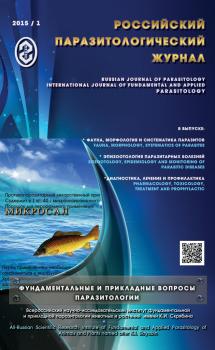Objective of research: The study of eosinophilic reaction in blood at experimental dictycaulosis of young sheep and after providing the complex therapy. Materials and methods: The research was conducted in August- September 2013at an experimental farm «Kurilovo» in Podolsk district of Moscow region. Six mongrel lambs at 4–5 months of age, free from infection, and 18 lambs experimentally infected with Dictyocaulus filarial at gtye dose of 1000 larvae per head were investigated. 30 days after invasion, lambs were divided into 3 equal groups (6 head in each) and kept under conditions excluding the possibility of spontaneous invasion. Lambs of the first group free from infection, served as controls and did not receive the drug. Infected animas of the second group were not treated and served as controls. Lambs of the third group received Alben as 20% granulated powder at the dose of 5 mg a.i./kg (0,25 g of granules per 10 kg of body weight); the fourth group of lambs received Alben at the same dose and subcutaneously T-activin at the dose of 2 mkg/kg once a day on the 1st , 3rd and 7th day of invasion, and В-activin at the dose of 5 mkg/ kg intramusculary once a day during 5 days. Before the experiment and after 7, 15, 30 and 60 days of treatment, blood samples were taken from calves. Trilon B was used as anticoagulant. Blood eosinophil levels were measured by the standard method. Results and discussion: Persistent blood eosinophilia was determined at experimental dictycaulosis in lambs. The level of eosinophils cannot be fully restored by dehelmintization with Alben. The full restoration of the quantity of eosinophils in blood of infected lambs occurs after the complex therapy with Alben in combination with T and В-activin.
lambs, Dictyocaulus filaria, therapy, Alben, T and В-activin, eosinophilia.
Введение
Диктикаулез овец широко распространен в России и вызывает тяжелую патологию, в результате чего значительно снижается продуктивность, а нередко происходит их падеж [4, 6]. Кроме того, научный и практический интерес имеет влияние инвазии на реакцию эозинофилов в защитных механизмах при диктиокаулезе ягнят.
Реакция организма млекопитающих против гельминтов включает активирование эозинофилов [5, 7]. Одновременное применение антигельминтиков в сочетании с иммуностимуляцией повышает эффективность лечения и иммунный статус организма [1, 2].
В связи с этим целью нашей работы было изучение влияния диктиокаулезной инвазии и комплексной терапии альбеном и Т- и В-активином на содержание эозинофилов в крови экспериментально инвазированных ягнят.
1. Daugalieva E.H., Kurochkina K.G., Shemyakova S.A. Perspectives in using of immunomodulators in the complex therapy of helminthoses. Tr. Vseros. in-ta gel’mintol [Proc. of the All -Russ. Inst. of Helminthol.], 2003, vol. 39, pp. 82-88.
2. Ershov V.S., Daugalieva E. H., Non-specific prophylaxis of helminthoses. Dokl. VASHNIL [Proc. of Lenin All-Union Academy of Agricultural Sciences], 1982, no.12, pp. 37-39.
3. Kondrahin I.P. Metody veterinarnoy klinicheskoy laboratornoy diagnostiki [Methods for clinical veterinary laboratory diagnostics]. M., Kolos, 2004. 520 p.
4. Lemekhov B.A. Economic damage from dyctiocaulosis. Veterinariya Vet. Medicine], 1987. no. 8, pp. 50-51.
5. Markin A.V., Tikhomirov E.P., Dotsenko V.A. et al. Diagnostic value of eosinophilia at associative parasitocenoses. Assotsiativnye parazitarnye bolezni, problemy ekologii i terapii.[ Associative parasitic diseases, problems of ecology and therapy]. M., 1995, pp. 98-100.
6. Safiullin R.T. Economic justification of parasitic diseases in cattle. Mater. nauch. konf. Vseros. o-va gel’mintol. RAN «Teoriya i praktika bor’by s parazitarnymi boleznyami». [Proc. of sci. conf. «Theory and practice of the struggle against parasitic diseases»]. M., 2002, i. 3, pp. 297-300.
7. Baikench M.G., Magnaval J.E. Eosinophiles, IgE et helminthiases. Rev. Med. Vet. (Fr.), 1993, vol. 144, no 12, pp. 967-974.





